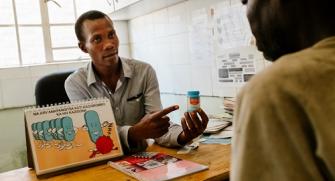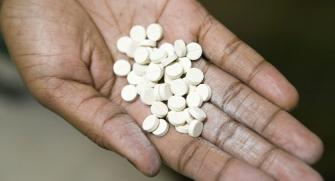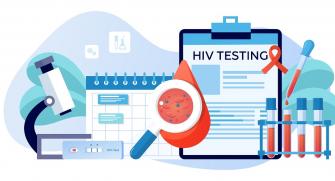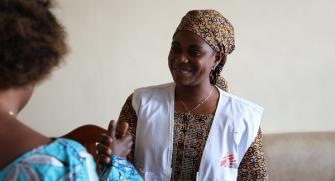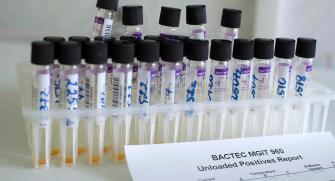HIV/AIDS
Nearly 40 million people live with HIV, more than two-thirds live in Africa: Since the start of the epidemic in the 1980s 76 million people have become infected with HIV.Important advances have been made in recent years. By 2023, 630,000 people had died of HIV-related causes and 1.3 million had contracted HIV.
The widespread availability of anti-retroviral (ARV) therapy over the past decade has made a dramatic difference in the survival and transmission rates. Together with its partners, UNAIDS has set a global goal for 2030: 95-95-95, which means the target is to diagnose 95% of all HIV-positive persons, provide ARV therapy for 95% of those diagnosed, and achieve viral suppression for 95% of those treated by 2030. By 2023, WHO estimated that 86% of people living with HIV knew their status, 76% were receiving antiretroviral treatment and 71% had achieved viral load suppression.
Current ARV therapies involve life-long treatment with a minimum of 3 drugs. This is a challenge on the personal patient level, but also at the level of health systems.
Médecins Sans Frontières (MSF) has been treating people infected with HIV since 2000. Alongside MSF, Epicentre has contributed by conducting research projects that demonstrate to the Ministries of Health, donors and the scientific community the feasibility of treating high number of patients in resource-limited settings.
Point of Care (POC) viral load monitoring in Malawi; Early Infant Diagnosis (EID) in Uganda
To reduce the number of new HIV infections early detection and the prescription of effective treatments is important, especially among HIV-infected mothers and their new-borns. In addition, it is important to monitor the treatments effectiveness; an ineffective treatment should be detected early so that the combination of drugs can be adjusted, i.e a switch to 2nd or 3rd line treatment. This detection is best not based on a sole clinical assessment of a patient’s condition as this is often too late. The current gold standard tool to monitor the treatment effectiveness is to measure the HIV viral load. A suppressed viral load indicates that the regimen prescribed is working well and that virus cannot be transmitted.
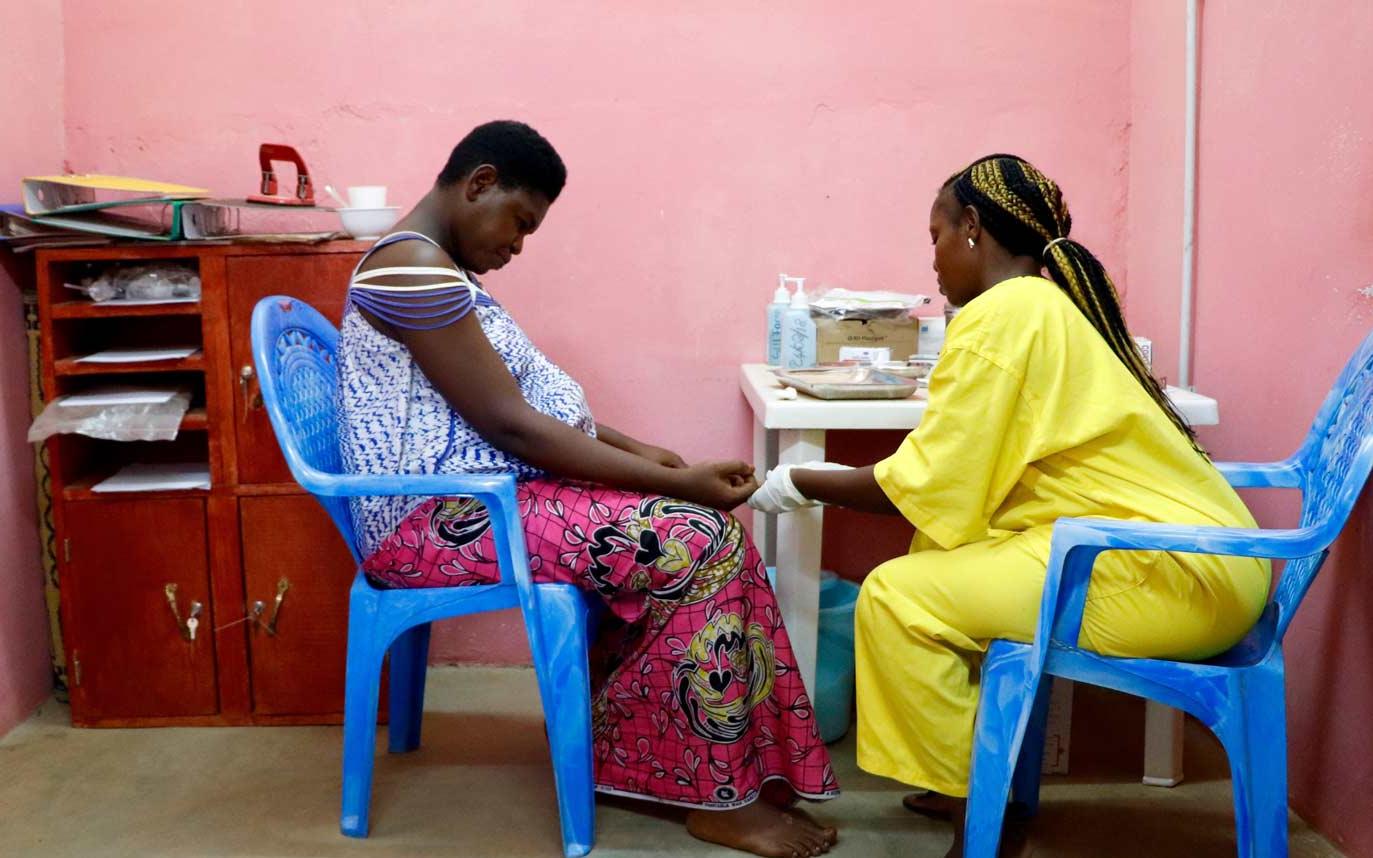
Measuring viral load involves complex equipment capable of performing so-called PCR tests, whereby copies of the virus can be quantified. Operating this equipment required high-level infrastructure and qualified technicians, which is why in low- and middle-income countries these are typically located in centralized laboratories. This is an impediment to rapid access to results for patients and clinicians alike.
In recent years, Point-Of-Care (POC) devices have been developed and are proving to be a good tool in settings where complex technology is not easy to implement. POC devices permit a same day result opposed to several weeks, sometimes months. This same day result allows prompt action, such as adherence counselling, switch to 2nd or 3rd line regimen.
In Malawi and Uganda Epicentre has had research projects with SAMBA (Simple Amplification Based Assay), one such recent POC method that can detect and monitor early HIV infection in newborns exposed to HIV through their mothers during pregnancy. Early Infant Diagnosis (EID) test results can be made available within a day and treatment, such as ARV initiation, can be started promptly. Viral load measurement through this method also helps to monitor the effectiveness of the ART regimen so that adjustments can be made if necessary. SAMBA-2 therefore appears to be a good tool for rapid diagnosis and initiation of HIV treatment in children under 18 months of age.
Assessing Cascade of Care
Epicentre has conducted population level studies to assess ART programs after several years. Several questions can be addressed with such studies: HIV prevalence and incidence, level of awareness HIV status of the population, linkage to care, viral load suppression at population level. These are key indicators to assess the so-called cascade of care. Progress can be measured of the different steps in HIV treatment and care, gaps can be identified, and goals can be formulated.
In some cases Epicentre has been able to conduct surveys before and after an MSF intervention so that results can be measured.
Testing and Treatment
For years, Ndhiwa sub-county has had one of the highest HIV prevalence rates in Kenya and all of Africa. A 2012 Epicentre survey of MSF sites conducted pointed to the need to improve care in all aspects, which led in 2014 to the following changes:
- raise awareness of the need to know one's HIV status,
- maximizing the number of HIV-positive people on antiretroviral therapy (ART)
- increase the number of people on ART with an undetectable viral load.
The goal was to reduce the rate of new infections and ultimately the presence of the virus in the population.
In 2018, Epicentre conducted a new survey called NHIPS 2 that included 6,020 people aged 15-59 years living in Ndhiwa sub-county (population 114,480). Comparing with the results of the 2021 survey, it was shown that
- the overall HIV prevalence had decreased from 24% to 17%.
- -over 90% of the population knew their HIV status
- more than 90% of positive people are on treatment
- More than 90% of patients on treatment are viral load free.
This survey highlights the effectiveness of the new screening approach that has been put in place, but also its benefits in terms of prevention. The principle is that when HIV treatment is effective, the viral load decreases so much that people can no longer transmit the virus. When applied to a large number of people, HIV treatment is then equivalent to HIV prevention.
HIV: Adolescents and young adults, a particularly high-risk population
While progress has been made in diagnosing, treating and suppressing the viral load of people living with HIV, the situation remains particularly worrying among younger people, as confirmed by a study carried out by Epicentre in 5 contexts in East and Southern Africa.
All ages combined in the cohorts in these 5 contexts in Eastern and Southern Africa, 73% of people living with HIV were diagnosed, 79% of those diagnosed were on ARV treatment and 88% of those on ARV had their viral load permanently suppressed. The proportion of undiagnosed people is increasing among the youngest age groups: only 1 in 2 teenagers and young adults living with HIV is diagnosed, compared with more than 8 in 10 in the 45-54 age group. And only 60% of diagnosed adolescents and young adults are on antiretroviral treatment. Treatment coverage also appears to be poorer, with fewer than 78% of 15–25-year-olds on treatment having their viral load suppressed (below 1,000 copies/mL), compared with 92% of 45-59-year-olds.
Improving adherence to treatment by adapting to the needs of different populations
Models tailored to specific populations
ARV therapy is a lifelong treatment consisting of at least 3 drugs and is sometimes accompanied by short and/ or long-term side effects. To avoid development and spread of drug-resistant HIV, it is crucial that patients strictly comply with the treatment requirements. This is why HIV management programs need to support patients, because, although patients understand the importance of regular treatment, it is often hard to continue to adhere to a treatment that can have such severe constraints. Epicentre conducted qualitative studies highlighting these constraints faced by patients.
The aim is to reduce non-compliance that contributes to the emergence of drug-resistance requiring a switch to more expensive 2nd or 3rd line treatments, or, even worse run out of treatment options altogether. In recent years, MSF France has developed programs in three East African countries with three different approaches: in Uganda, MSF supports Arua regional reference hospital’s AERT clinic; in Kenya and Malawi, interventions have been developed in rural districts, mainly at the health center level, but with a different approach.
Targeting particular age groups such as adolescents
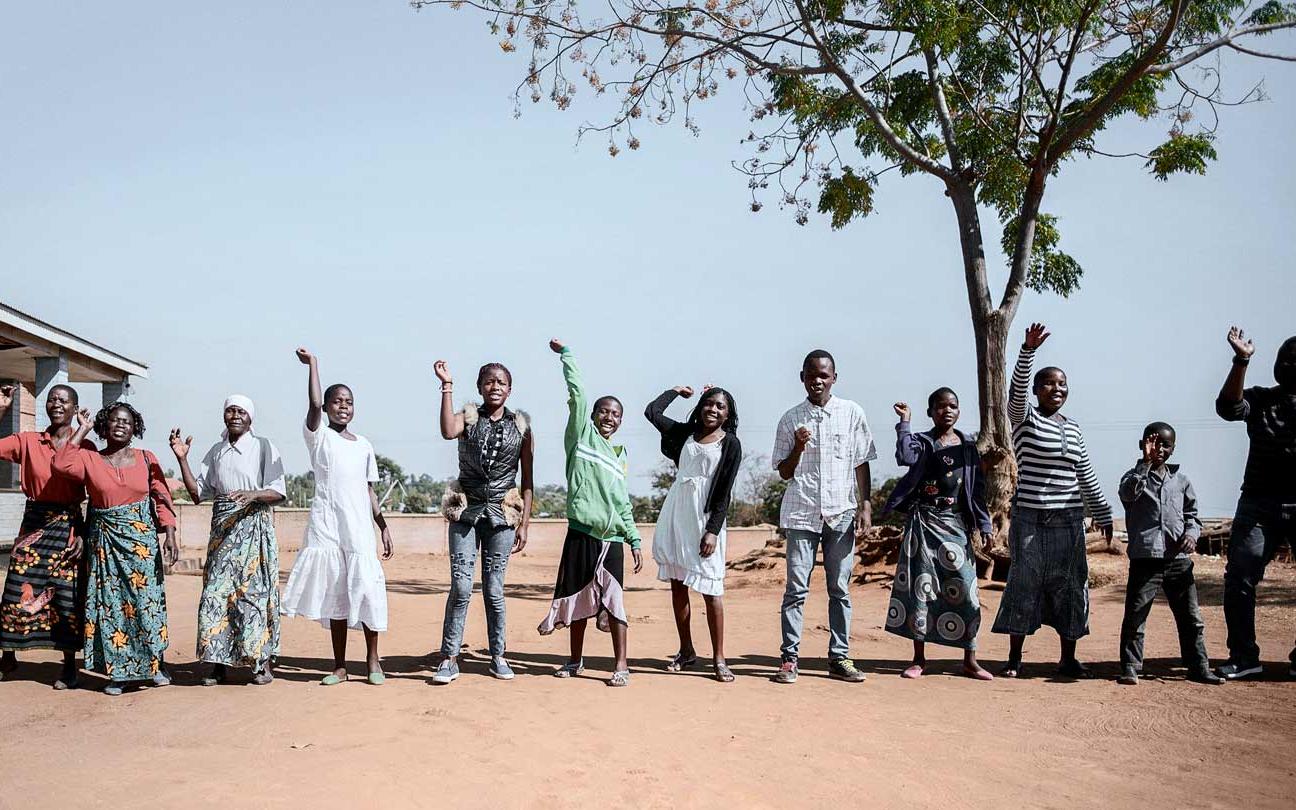
Factors explaining under-diagnosis include stigma, but also lower use of health centres by men and the impact in terms of acceptance of diagnosis and treatment. Some young adults prefer to self-diagnose, which proves that age-appropriate solutions exist and can be implemented. But this requires healthcare systems to make specific provision for adolescents and young adults, which is hardly the case in most countries. After having benefited from very close monitoring in pediatric services, young people most often switch without any transition or support to services dedicated to adults. As a result, a number of them leave care. The implementation and evaluation of dedicated interventions adapted to this age group, such as the "teens clubs" deployed by MSF appear to be able to limit this break with care and improve diagnosis, as well as engagement and retention in HIV treatment and care.
Since 2017, Médecins Sans Frontières (MSF) developed and introduced dedicated "Teens clubs" for adolescents living with HIV in the rural district of Chiradzulu (Malawi) and the town of Arua (Uganda) in two long term projects in partnership with the Ministry of Health.
A qualitative and quantitative study carried out with Epicentre has made it possible to evaluate these programmes, documenting their implementation, assessing their effectiveness and suggesting improvements. Both projects have high retention rates, with more than 90% of adolescents remaining in care. In Chiradzulu, viral load coverage and the proportion of people whose viral load was suppressed or re-suppressed increased substantially. In Arua, these indicators changed less radically, because the rates were already high at the start of the implementation. These clubs offer teenagers a safe space to receive HIV follow-up and care and to talk about their disease with their peers.
Adapting to lifestyles
In recent years, MSF France has supported local authorities in implementing decentralized care models, notably in Goma in the DRC, in fishing communities around Lake George and Lake Edward in western Uganda, and in Carnot in the CAR. Epicentre evaluated the implementation of these programs.
In Uganda, a survey carried out by Epicentre in 2016 revealed that fishermen's mobility and limited access to treatment sites were cited as two major obstacles to viral load suppression. MSF has set up two less restrictive modes of treatment delivery: one where fishermen collect their medicines from the pharmacy without going through the normal clinical flow, including examination by a doctor, the other where a fisherman who changes each time collects the medicines for the whole community. Retention in care was high in both models, with better retention observed in the community model.
In Goma, DRC, MSF supported the Ministry of Health in setting up a community delivery model where members take it in turns to collect ARVs, as opposed to the classic clinical model where people have to come in every 3 months to renew their ARVs, with or without consulting a health professional. At the end of 6 months, 98% and 94% of people were still in the community and clinical delivery models respectively. Coverage and viral suppression rates were similar in both models. At the end of one year, a sharper drop in retention was observed in the clinical model, and the risk of having people who died, were lost to follow-up or were displaced was reduced by 57% in the community group compared with the clinical model.
A study carried out in Carnot, Central African Republic (CAR), has revealed persistent challenges in HIV management. Despite the adoption of differentiated approaches, the high rates of death and loss of sight remain worrying. Distance to treatment facilities, safety during the journey, lack of food, stigmatization and differentiated models that struggle to adapt to patients' needs continue to be major obstacles to accessing treatment.
Sex workers: a highly exposed population
According to UNAIDS in 2019, female sex workers were 30 times more likely to contract HIV than the general female population. This figure obviously shows the overexposure of sex workers to HIV, but it doesn't tell us much about their experiences, their knowledge of their HIV status and other risks, or what they do to take care of themselves. Without this data, it's difficult to propose specific and adapted approaches in terms of prevention. From February to April 2019, Epicentre and Médecins sans Frontières (MSF), in collaboration with the Malawian Ministry of Health, conducted a study of female sex workers in Nsanje, one of Malawi's most disadvantaged districts, where a significant number of women are involved in the sex trade in workplaces with a high male population or along main roads.
More than half the participants were HIV-positive when they entered the study. HIV prevalence increased sharply with age, reaching 88% for sex workers over 35, compared with 14% for those aged 13 to 19. Most HIV-positive participants reported knowing their HIV status (9%), and of these, the majority (99%) were already on antiretroviral (ARV) treatment. Among adolescent girls, the UNAIDS target indicators were lower than those observed among adults: 85% of HIV-positive adolescents knew their serostatus, all were on ARV treatment and 63% had a suppressed viral load, compared with 84% of adults.
Assessing treatment resistance
As of 2019, WHO recommends the use of dolutegravir or low-dose efavirenz for first-line treatment due to the emergence of HIV resistance to ARVs.
Dolutegravir should be given with two nucleoside reverse transcriptase inhibitors (NRTIs) as first-line antiretroviral therapy. The previous first-line regimen consisted of one non-nucleoside reverse transcriptase inhibitor (NNRTI) molecule (primarily Efavirenz (EFV)) in combination with two NRTIs, Tenofovir (TDF) and Lamivudine.
A generic once-daily fixed-dose combination of tenofovir-lamivudine-dolutegravir (TLD) is now available in low- and middle-income countries. As a result, most sub-Saharan African countries have since adopted TLD as first-line treatment. One of the concerns surrounding this large-scale rollout is the lack of information on resistance to previously administered drugs in some patients.
In Malawi, the Epicentre-coordinated EMEDT study is supporting this first-line switch. Between January to May 2019, 1928 participants were enrolled and started on TLD first-line: among these 1892 participants who had already been on NNRTI-based ART and 35 who initiated ART with TLD. Study participants are followed up for up to 18 months post TLD treatment start. The main outcome is HIV viral load suppression, specifically among participants who had non-suppressed VL and drug resistance at TLD start.
This was the first assessment of the impact of a mass transition to first-line TLD without viral load testing, and the first data on long-term outcomes of TLD use in an African setting outside a clinical trial. The high levels of viral suppression and infrequent viral failures observed after one year of TLD support Malawi's pragmatic mass transition strategy and, encouragingly, pre-existing resistance to the NNRTI lamivudine and tenofovir disoproxil fumarate did not compromise viral load suppression on TLD up to 18 months of TLD.
In collaboration with MSF, Epicentre also studied ARV resistance in Mozambique, in the capital Maputo and in Tete, a more rural district in the north of the country, among treated patients, but also among so-called naive people, i.e., those who have never taken anti-HIV therapy or who are restarting ARV treatment after an interruption of more than 3 months.
As a result, less than 10% of patients in Maputo and about 16% in Tete are in virological failure. On the other hand, 90% of patients in virological failure have developed resistance to at least one of the most commonly used molecules during ARV treatment. And double resistance to Tenofovir/Lamivudine - two molecules prescribed in combination with Dolutegravir as a new first line treatment - affects more than half of the people in treatment failure.
These results confirm that switching to a first-line regimen based on dolutegravir should be accompanied by viral load assessment and resistance genotyping.
Another study conducted this time if the DRC and Kenya by Epicentre demonstrates the need to improve access to viral load testing and resistance genotyping in advanced HIV patients. In ¾ of the patients admitted to a hospital in Kinshasa and Homa Bay with advanced HIV, two of the three molecules of their antiretroviral therapy were found to be ineffective. A change in treatment should be considered at the first detection of elevated viremia in patients with CD4 counts ≤350 cells/ml or when the viral load is not available before hospital discharge for those with CD4 counts ≤100 cells/ml. These results have in fact contributed to the publication of new clinical guidelines for HIV prevention, treatment, and care from the WHO.







